NHS England Report: Analysis of HR Issues and Management Strategies
VerifiedAdded on 2022/11/25
|14
|3603
|373
Report
AI Summary
This report presents a comprehensive analysis of the human resource challenges facing NHS England. It identifies key issues such as staff shortages, poor wages, high employee turnover, ineffective training programs, and leadership deficiencies. The report delves into the Maslow's hierarchy of needs and transformational leadership theories to explain the leadership and management issues. It explores the impact of these problems on healthcare services and the morale of staff. The report highlights the importance of leadership diversity, training and development, and talent management. Recommendations include improving leadership recognition, implementing effective training programs, and developing strategies to retain employees. The report emphasizes the need for a supportive work environment and equal opportunities for all employees to ensure the NHS can provide better healthcare services to the public. The report is contributed by a student to be published on the website Desklib, a platform which provides all the necessary AI based study tools for students.
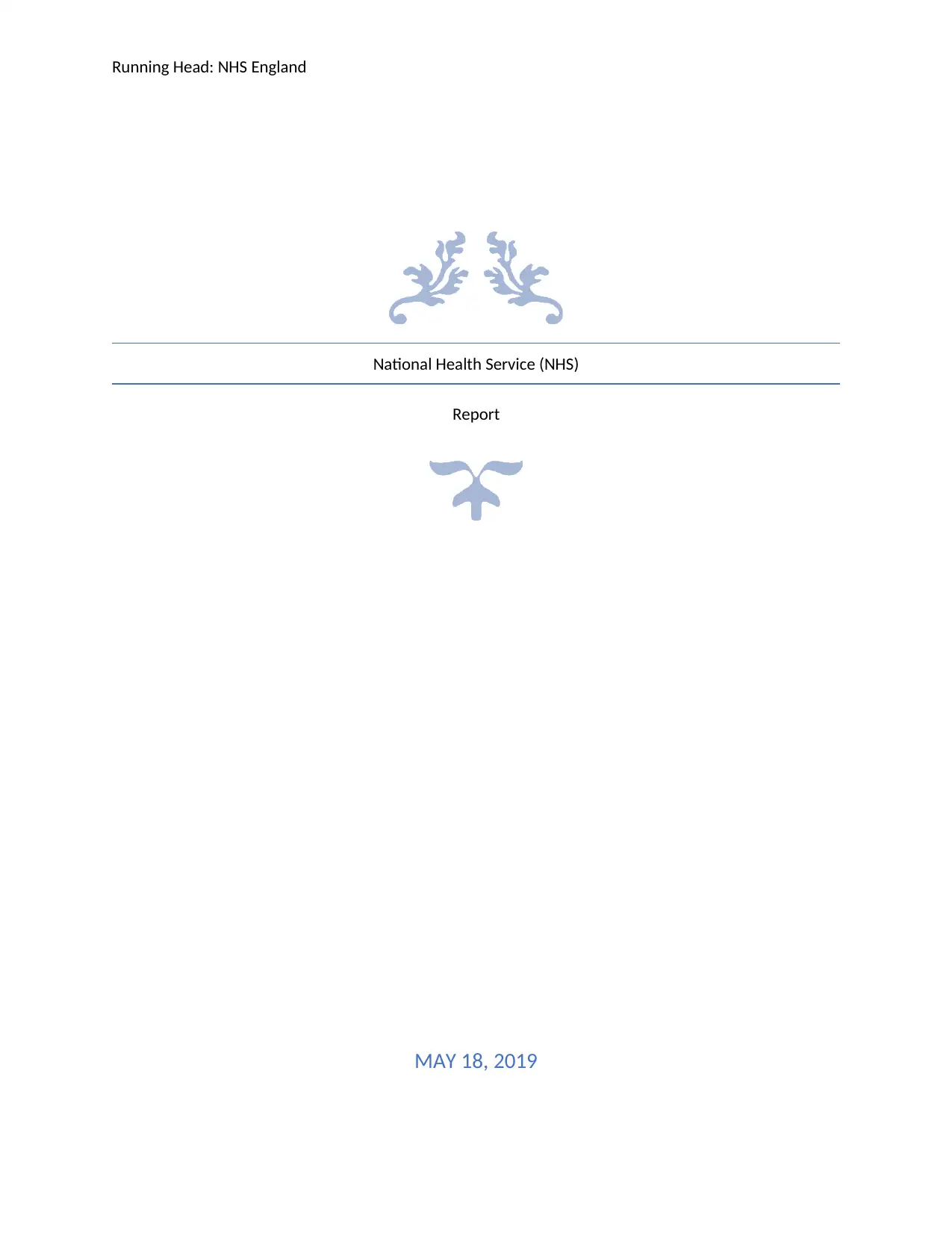
Running Head: NHS England
National Health Service (NHS)
Report
MAY 18, 2019
National Health Service (NHS)
Report
MAY 18, 2019
Paraphrase This Document
Need a fresh take? Get an instant paraphrase of this document with our AI Paraphraser
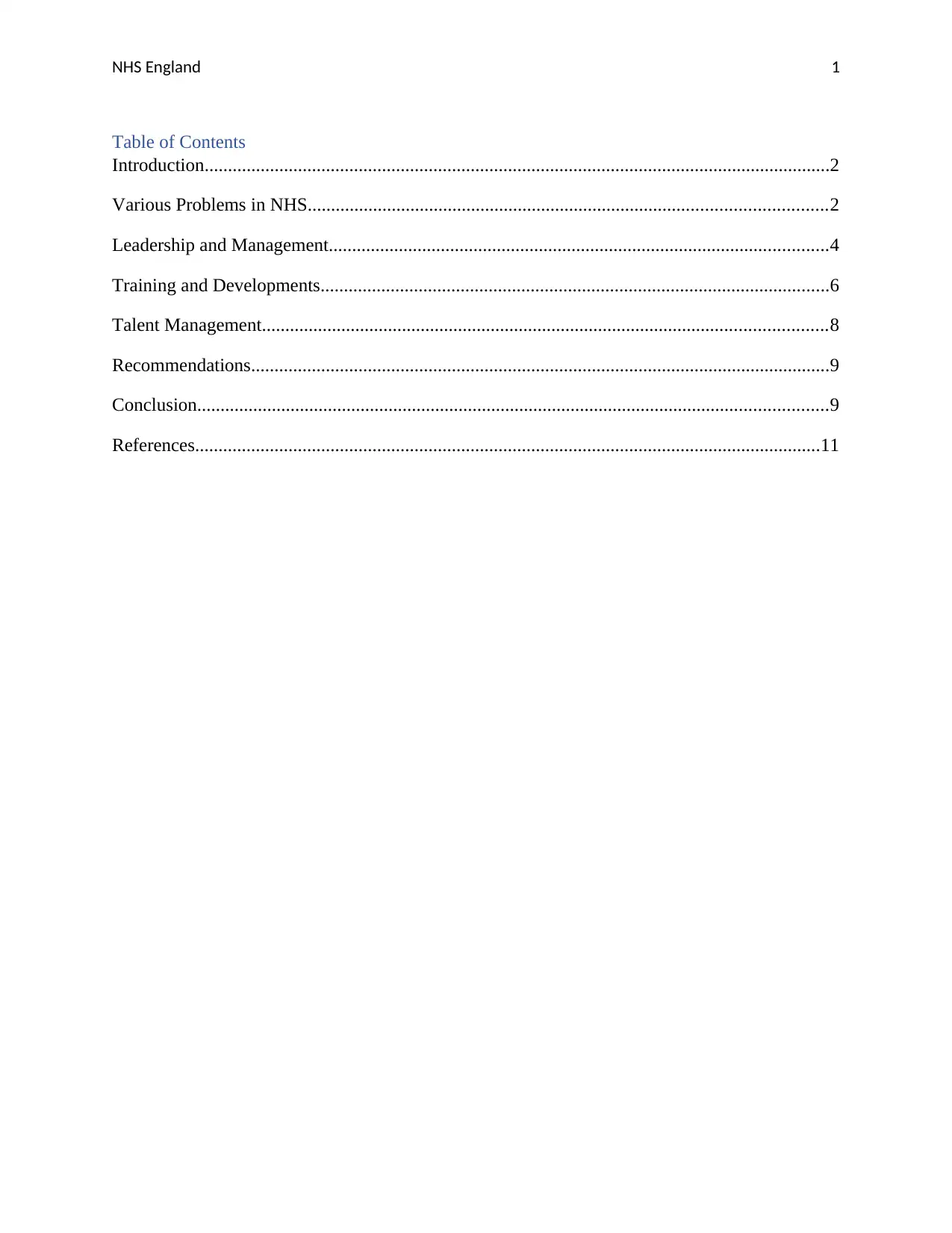
NHS England 1
Table of Contents
Introduction......................................................................................................................................2
Various Problems in NHS...............................................................................................................2
Leadership and Management...........................................................................................................4
Training and Developments.............................................................................................................6
Talent Management.........................................................................................................................8
Recommendations............................................................................................................................9
Conclusion.......................................................................................................................................9
References......................................................................................................................................11
Table of Contents
Introduction......................................................................................................................................2
Various Problems in NHS...............................................................................................................2
Leadership and Management...........................................................................................................4
Training and Developments.............................................................................................................6
Talent Management.........................................................................................................................8
Recommendations............................................................................................................................9
Conclusion.......................................................................................................................................9
References......................................................................................................................................11
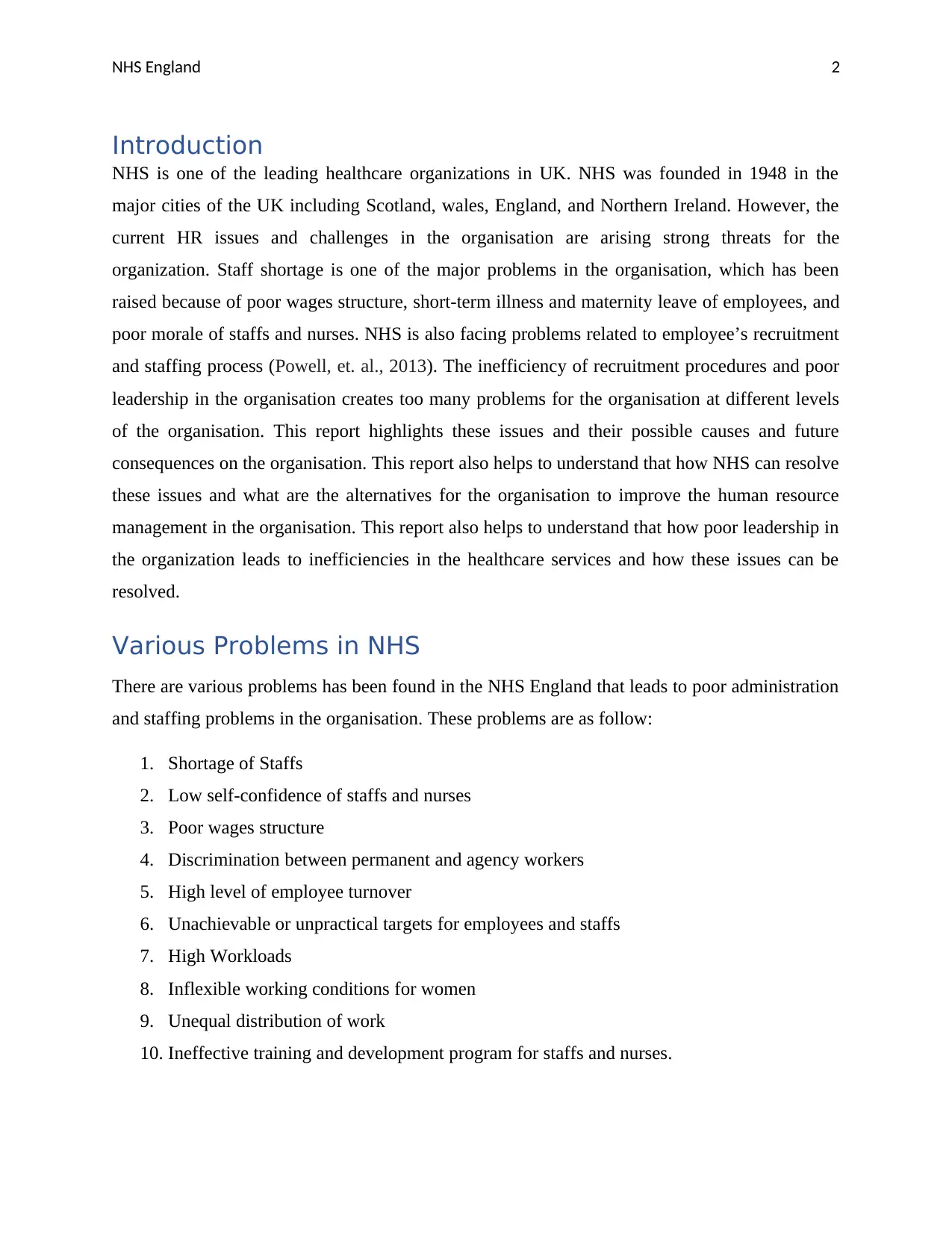
NHS England 2
Introduction
NHS is one of the leading healthcare organizations in UK. NHS was founded in 1948 in the
major cities of the UK including Scotland, wales, England, and Northern Ireland. However, the
current HR issues and challenges in the organisation are arising strong threats for the
organization. Staff shortage is one of the major problems in the organisation, which has been
raised because of poor wages structure, short-term illness and maternity leave of employees, and
poor morale of staffs and nurses. NHS is also facing problems related to employee’s recruitment
and staffing process (Powell, et. al., 2013). The inefficiency of recruitment procedures and poor
leadership in the organisation creates too many problems for the organisation at different levels
of the organisation. This report highlights these issues and their possible causes and future
consequences on the organisation. This report also helps to understand that how NHS can resolve
these issues and what are the alternatives for the organisation to improve the human resource
management in the organisation. This report also helps to understand that how poor leadership in
the organization leads to inefficiencies in the healthcare services and how these issues can be
resolved.
Various Problems in NHS
There are various problems has been found in the NHS England that leads to poor administration
and staffing problems in the organisation. These problems are as follow:
1. Shortage of Staffs
2. Low self-confidence of staffs and nurses
3. Poor wages structure
4. Discrimination between permanent and agency workers
5. High level of employee turnover
6. Unachievable or unpractical targets for employees and staffs
7. High Workloads
8. Inflexible working conditions for women
9. Unequal distribution of work
10. Ineffective training and development program for staffs and nurses.
Introduction
NHS is one of the leading healthcare organizations in UK. NHS was founded in 1948 in the
major cities of the UK including Scotland, wales, England, and Northern Ireland. However, the
current HR issues and challenges in the organisation are arising strong threats for the
organization. Staff shortage is one of the major problems in the organisation, which has been
raised because of poor wages structure, short-term illness and maternity leave of employees, and
poor morale of staffs and nurses. NHS is also facing problems related to employee’s recruitment
and staffing process (Powell, et. al., 2013). The inefficiency of recruitment procedures and poor
leadership in the organisation creates too many problems for the organisation at different levels
of the organisation. This report highlights these issues and their possible causes and future
consequences on the organisation. This report also helps to understand that how NHS can resolve
these issues and what are the alternatives for the organisation to improve the human resource
management in the organisation. This report also helps to understand that how poor leadership in
the organization leads to inefficiencies in the healthcare services and how these issues can be
resolved.
Various Problems in NHS
There are various problems has been found in the NHS England that leads to poor administration
and staffing problems in the organisation. These problems are as follow:
1. Shortage of Staffs
2. Low self-confidence of staffs and nurses
3. Poor wages structure
4. Discrimination between permanent and agency workers
5. High level of employee turnover
6. Unachievable or unpractical targets for employees and staffs
7. High Workloads
8. Inflexible working conditions for women
9. Unequal distribution of work
10. Ineffective training and development program for staffs and nurses.
⊘ This is a preview!⊘
Do you want full access?
Subscribe today to unlock all pages.

Trusted by 1+ million students worldwide
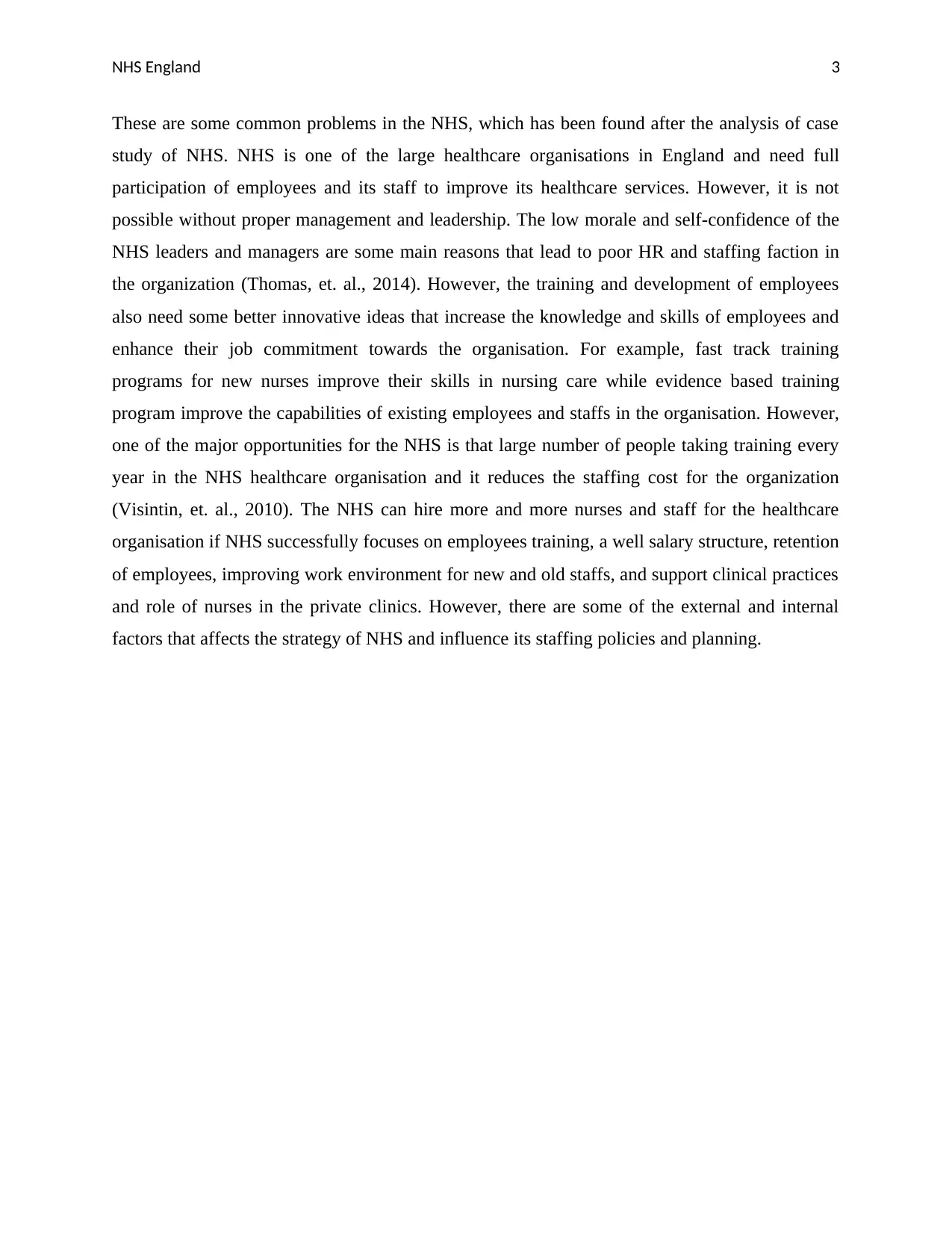
NHS England 3
These are some common problems in the NHS, which has been found after the analysis of case
study of NHS. NHS is one of the large healthcare organisations in England and need full
participation of employees and its staff to improve its healthcare services. However, it is not
possible without proper management and leadership. The low morale and self-confidence of the
NHS leaders and managers are some main reasons that lead to poor HR and staffing faction in
the organization (Thomas, et. al., 2014). However, the training and development of employees
also need some better innovative ideas that increase the knowledge and skills of employees and
enhance their job commitment towards the organisation. For example, fast track training
programs for new nurses improve their skills in nursing care while evidence based training
program improve the capabilities of existing employees and staffs in the organisation. However,
one of the major opportunities for the NHS is that large number of people taking training every
year in the NHS healthcare organisation and it reduces the staffing cost for the organization
(Visintin, et. al., 2010). The NHS can hire more and more nurses and staff for the healthcare
organisation if NHS successfully focuses on employees training, a well salary structure, retention
of employees, improving work environment for new and old staffs, and support clinical practices
and role of nurses in the private clinics. However, there are some of the external and internal
factors that affects the strategy of NHS and influence its staffing policies and planning.
These are some common problems in the NHS, which has been found after the analysis of case
study of NHS. NHS is one of the large healthcare organisations in England and need full
participation of employees and its staff to improve its healthcare services. However, it is not
possible without proper management and leadership. The low morale and self-confidence of the
NHS leaders and managers are some main reasons that lead to poor HR and staffing faction in
the organization (Thomas, et. al., 2014). However, the training and development of employees
also need some better innovative ideas that increase the knowledge and skills of employees and
enhance their job commitment towards the organisation. For example, fast track training
programs for new nurses improve their skills in nursing care while evidence based training
program improve the capabilities of existing employees and staffs in the organisation. However,
one of the major opportunities for the NHS is that large number of people taking training every
year in the NHS healthcare organisation and it reduces the staffing cost for the organization
(Visintin, et. al., 2010). The NHS can hire more and more nurses and staff for the healthcare
organisation if NHS successfully focuses on employees training, a well salary structure, retention
of employees, improving work environment for new and old staffs, and support clinical practices
and role of nurses in the private clinics. However, there are some of the external and internal
factors that affects the strategy of NHS and influence its staffing policies and planning.
Paraphrase This Document
Need a fresh take? Get an instant paraphrase of this document with our AI Paraphraser
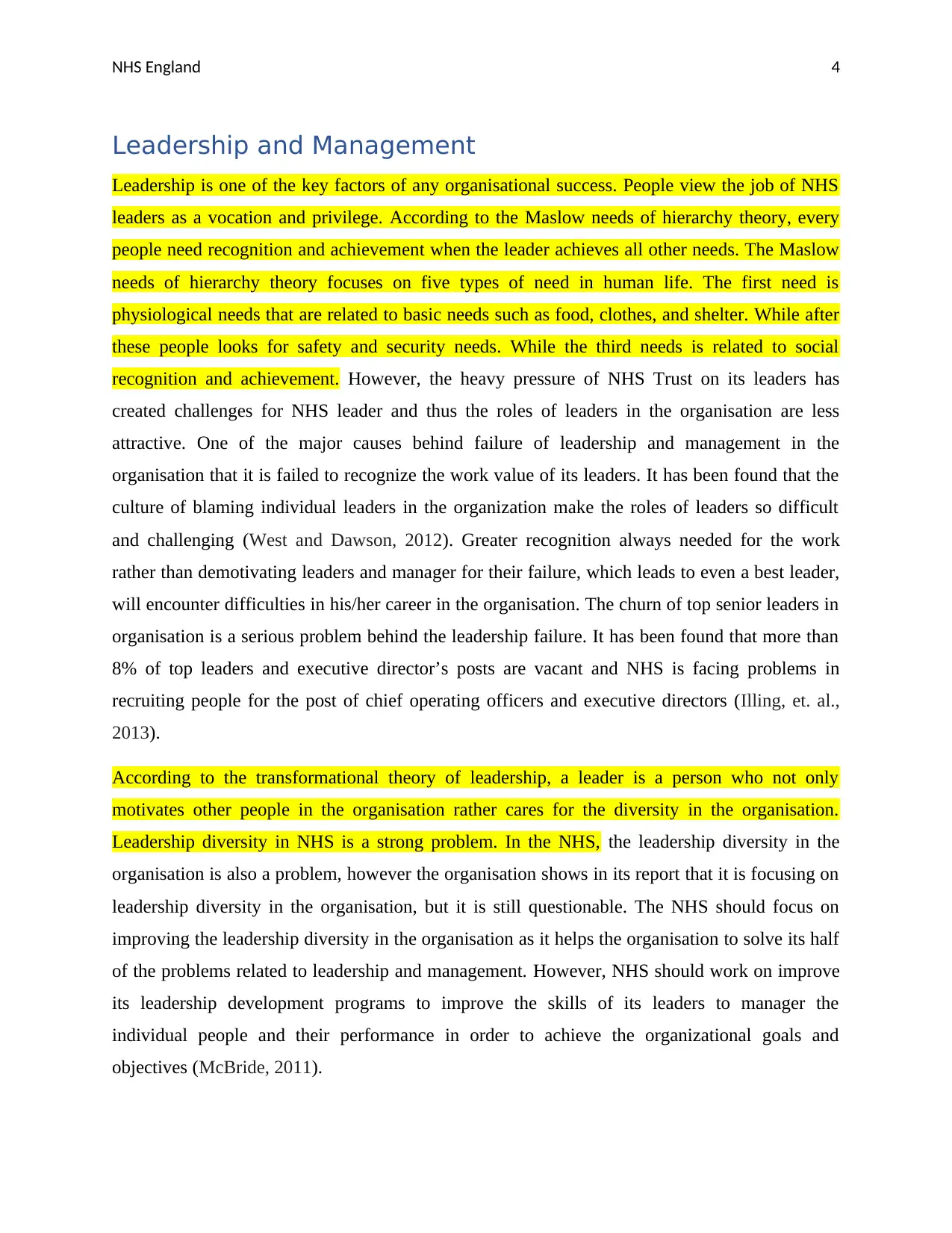
NHS England 4
Leadership and Management
Leadership is one of the key factors of any organisational success. People view the job of NHS
leaders as a vocation and privilege. According to the Maslow needs of hierarchy theory, every
people need recognition and achievement when the leader achieves all other needs. The Maslow
needs of hierarchy theory focuses on five types of need in human life. The first need is
physiological needs that are related to basic needs such as food, clothes, and shelter. While after
these people looks for safety and security needs. While the third needs is related to social
recognition and achievement. However, the heavy pressure of NHS Trust on its leaders has
created challenges for NHS leader and thus the roles of leaders in the organisation are less
attractive. One of the major causes behind failure of leadership and management in the
organisation that it is failed to recognize the work value of its leaders. It has been found that the
culture of blaming individual leaders in the organization make the roles of leaders so difficult
and challenging (West and Dawson, 2012). Greater recognition always needed for the work
rather than demotivating leaders and manager for their failure, which leads to even a best leader,
will encounter difficulties in his/her career in the organisation. The churn of top senior leaders in
organisation is a serious problem behind the leadership failure. It has been found that more than
8% of top leaders and executive director’s posts are vacant and NHS is facing problems in
recruiting people for the post of chief operating officers and executive directors (Illing, et. al.,
2013).
According to the transformational theory of leadership, a leader is a person who not only
motivates other people in the organisation rather cares for the diversity in the organisation.
Leadership diversity in NHS is a strong problem. In the NHS, the leadership diversity in the
organisation is also a problem, however the organisation shows in its report that it is focusing on
leadership diversity in the organisation, but it is still questionable. The NHS should focus on
improving the leadership diversity in the organisation as it helps the organisation to solve its half
of the problems related to leadership and management. However, NHS should work on improve
its leadership development programs to improve the skills of its leaders to manager the
individual people and their performance in order to achieve the organizational goals and
objectives (McBride, 2011).
Leadership and Management
Leadership is one of the key factors of any organisational success. People view the job of NHS
leaders as a vocation and privilege. According to the Maslow needs of hierarchy theory, every
people need recognition and achievement when the leader achieves all other needs. The Maslow
needs of hierarchy theory focuses on five types of need in human life. The first need is
physiological needs that are related to basic needs such as food, clothes, and shelter. While after
these people looks for safety and security needs. While the third needs is related to social
recognition and achievement. However, the heavy pressure of NHS Trust on its leaders has
created challenges for NHS leader and thus the roles of leaders in the organisation are less
attractive. One of the major causes behind failure of leadership and management in the
organisation that it is failed to recognize the work value of its leaders. It has been found that the
culture of blaming individual leaders in the organization make the roles of leaders so difficult
and challenging (West and Dawson, 2012). Greater recognition always needed for the work
rather than demotivating leaders and manager for their failure, which leads to even a best leader,
will encounter difficulties in his/her career in the organisation. The churn of top senior leaders in
organisation is a serious problem behind the leadership failure. It has been found that more than
8% of top leaders and executive director’s posts are vacant and NHS is facing problems in
recruiting people for the post of chief operating officers and executive directors (Illing, et. al.,
2013).
According to the transformational theory of leadership, a leader is a person who not only
motivates other people in the organisation rather cares for the diversity in the organisation.
Leadership diversity in NHS is a strong problem. In the NHS, the leadership diversity in the
organisation is also a problem, however the organisation shows in its report that it is focusing on
leadership diversity in the organisation, but it is still questionable. The NHS should focus on
improving the leadership diversity in the organisation as it helps the organisation to solve its half
of the problems related to leadership and management. However, NHS should work on improve
its leadership development programs to improve the skills of its leaders to manager the
individual people and their performance in order to achieve the organizational goals and
objectives (McBride, 2011).
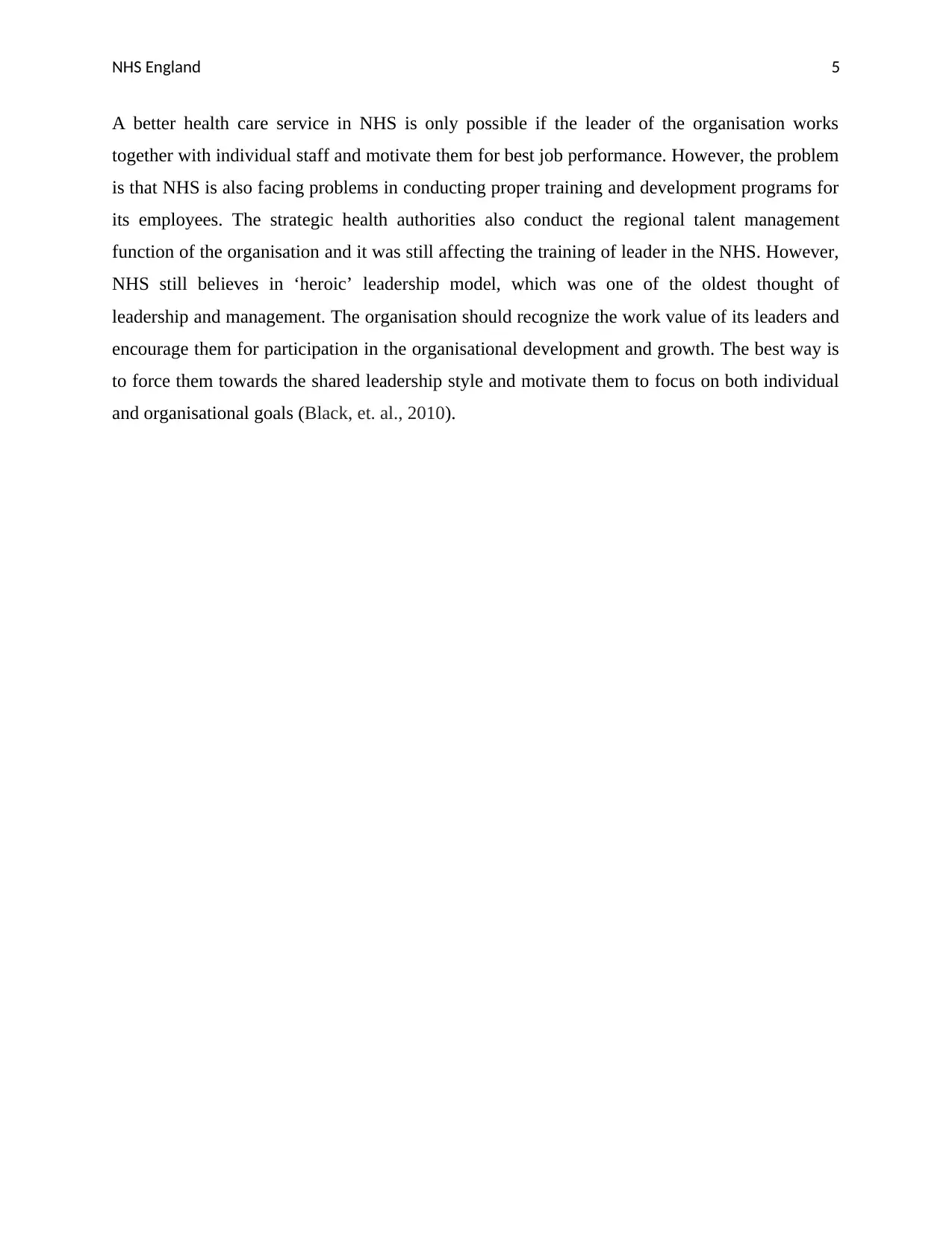
NHS England 5
A better health care service in NHS is only possible if the leader of the organisation works
together with individual staff and motivate them for best job performance. However, the problem
is that NHS is also facing problems in conducting proper training and development programs for
its employees. The strategic health authorities also conduct the regional talent management
function of the organisation and it was still affecting the training of leader in the NHS. However,
NHS still believes in ‘heroic’ leadership model, which was one of the oldest thought of
leadership and management. The organisation should recognize the work value of its leaders and
encourage them for participation in the organisational development and growth. The best way is
to force them towards the shared leadership style and motivate them to focus on both individual
and organisational goals (Black, et. al., 2010).
A better health care service in NHS is only possible if the leader of the organisation works
together with individual staff and motivate them for best job performance. However, the problem
is that NHS is also facing problems in conducting proper training and development programs for
its employees. The strategic health authorities also conduct the regional talent management
function of the organisation and it was still affecting the training of leader in the NHS. However,
NHS still believes in ‘heroic’ leadership model, which was one of the oldest thought of
leadership and management. The organisation should recognize the work value of its leaders and
encourage them for participation in the organisational development and growth. The best way is
to force them towards the shared leadership style and motivate them to focus on both individual
and organisational goals (Black, et. al., 2010).
⊘ This is a preview!⊘
Do you want full access?
Subscribe today to unlock all pages.

Trusted by 1+ million students worldwide
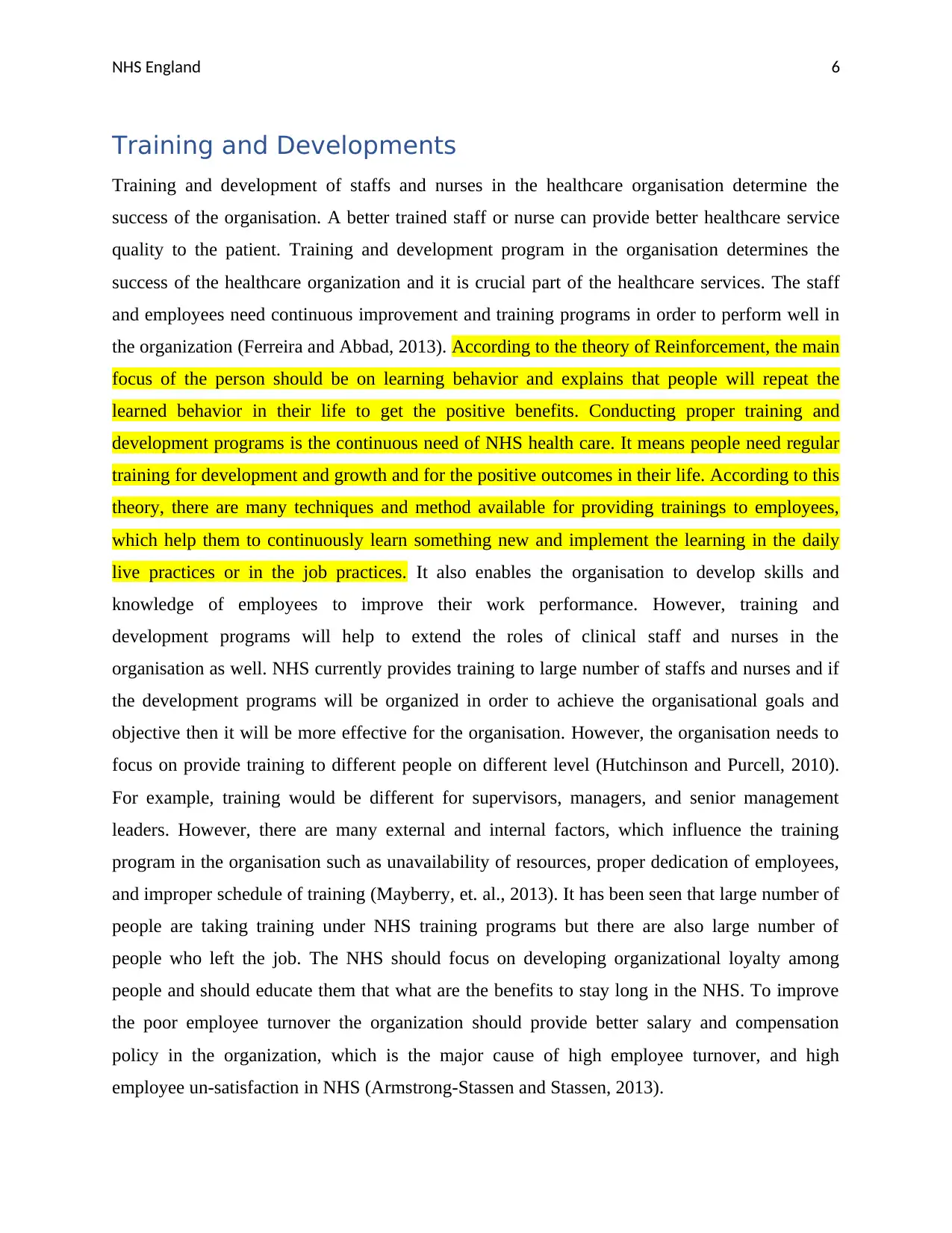
NHS England 6
Training and Developments
Training and development of staffs and nurses in the healthcare organisation determine the
success of the organisation. A better trained staff or nurse can provide better healthcare service
quality to the patient. Training and development program in the organisation determines the
success of the healthcare organization and it is crucial part of the healthcare services. The staff
and employees need continuous improvement and training programs in order to perform well in
the organization (Ferreira and Abbad, 2013). According to the theory of Reinforcement, the main
focus of the person should be on learning behavior and explains that people will repeat the
learned behavior in their life to get the positive benefits. Conducting proper training and
development programs is the continuous need of NHS health care. It means people need regular
training for development and growth and for the positive outcomes in their life. According to this
theory, there are many techniques and method available for providing trainings to employees,
which help them to continuously learn something new and implement the learning in the daily
live practices or in the job practices. It also enables the organisation to develop skills and
knowledge of employees to improve their work performance. However, training and
development programs will help to extend the roles of clinical staff and nurses in the
organisation as well. NHS currently provides training to large number of staffs and nurses and if
the development programs will be organized in order to achieve the organisational goals and
objective then it will be more effective for the organisation. However, the organisation needs to
focus on provide training to different people on different level (Hutchinson and Purcell, 2010).
For example, training would be different for supervisors, managers, and senior management
leaders. However, there are many external and internal factors, which influence the training
program in the organisation such as unavailability of resources, proper dedication of employees,
and improper schedule of training (Mayberry, et. al., 2013). It has been seen that large number of
people are taking training under NHS training programs but there are also large number of
people who left the job. The NHS should focus on developing organizational loyalty among
people and should educate them that what are the benefits to stay long in the NHS. To improve
the poor employee turnover the organization should provide better salary and compensation
policy in the organization, which is the major cause of high employee turnover, and high
employee un-satisfaction in NHS (Armstrong-Stassen and Stassen, 2013).
Training and Developments
Training and development of staffs and nurses in the healthcare organisation determine the
success of the organisation. A better trained staff or nurse can provide better healthcare service
quality to the patient. Training and development program in the organisation determines the
success of the healthcare organization and it is crucial part of the healthcare services. The staff
and employees need continuous improvement and training programs in order to perform well in
the organization (Ferreira and Abbad, 2013). According to the theory of Reinforcement, the main
focus of the person should be on learning behavior and explains that people will repeat the
learned behavior in their life to get the positive benefits. Conducting proper training and
development programs is the continuous need of NHS health care. It means people need regular
training for development and growth and for the positive outcomes in their life. According to this
theory, there are many techniques and method available for providing trainings to employees,
which help them to continuously learn something new and implement the learning in the daily
live practices or in the job practices. It also enables the organisation to develop skills and
knowledge of employees to improve their work performance. However, training and
development programs will help to extend the roles of clinical staff and nurses in the
organisation as well. NHS currently provides training to large number of staffs and nurses and if
the development programs will be organized in order to achieve the organisational goals and
objective then it will be more effective for the organisation. However, the organisation needs to
focus on provide training to different people on different level (Hutchinson and Purcell, 2010).
For example, training would be different for supervisors, managers, and senior management
leaders. However, there are many external and internal factors, which influence the training
program in the organisation such as unavailability of resources, proper dedication of employees,
and improper schedule of training (Mayberry, et. al., 2013). It has been seen that large number of
people are taking training under NHS training programs but there are also large number of
people who left the job. The NHS should focus on developing organizational loyalty among
people and should educate them that what are the benefits to stay long in the NHS. To improve
the poor employee turnover the organization should provide better salary and compensation
policy in the organization, which is the major cause of high employee turnover, and high
employee un-satisfaction in NHS (Armstrong-Stassen and Stassen, 2013).
Paraphrase This Document
Need a fresh take? Get an instant paraphrase of this document with our AI Paraphraser
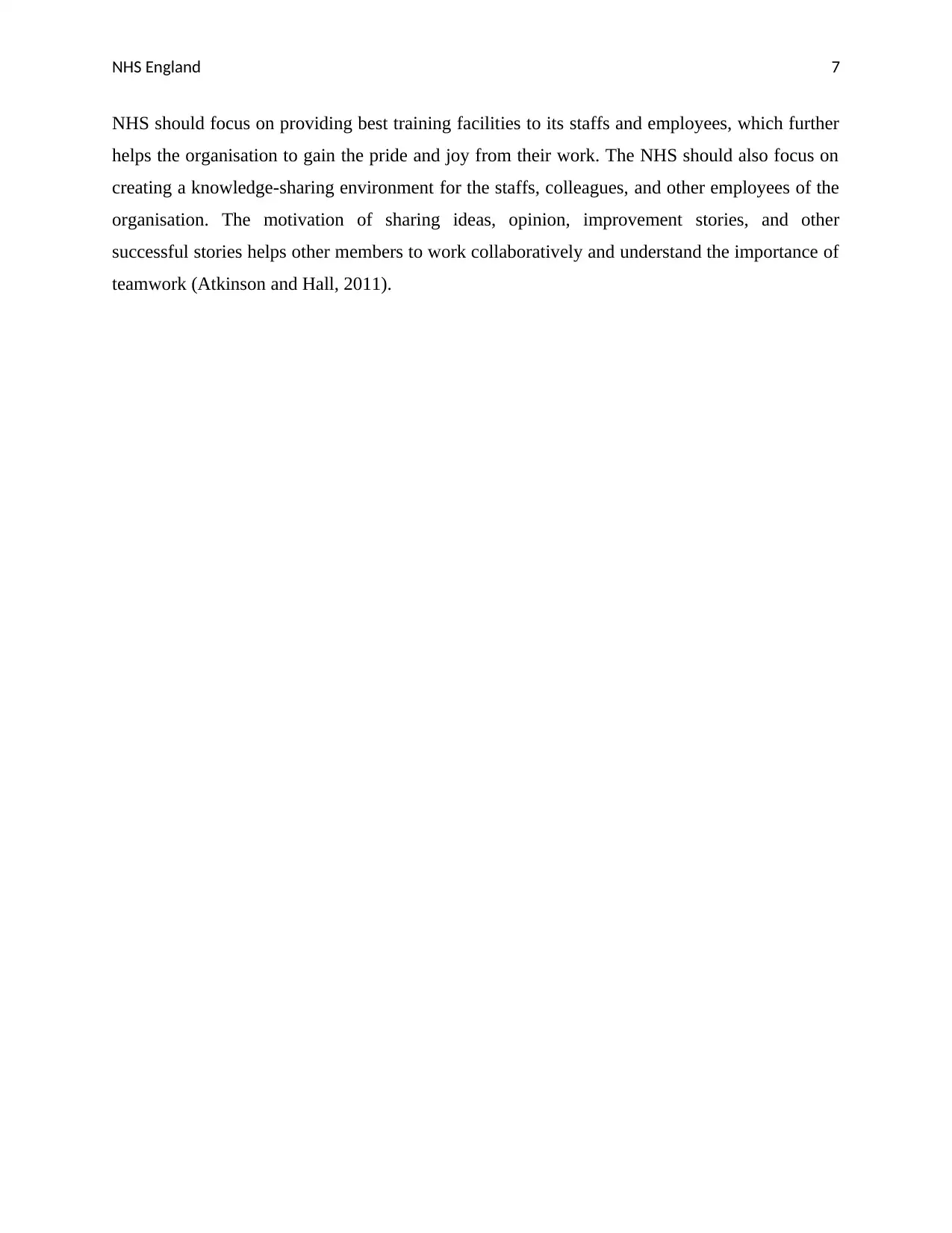
NHS England 7
NHS should focus on providing best training facilities to its staffs and employees, which further
helps the organisation to gain the pride and joy from their work. The NHS should also focus on
creating a knowledge-sharing environment for the staffs, colleagues, and other employees of the
organisation. The motivation of sharing ideas, opinion, improvement stories, and other
successful stories helps other members to work collaboratively and understand the importance of
teamwork (Atkinson and Hall, 2011).
NHS should focus on providing best training facilities to its staffs and employees, which further
helps the organisation to gain the pride and joy from their work. The NHS should also focus on
creating a knowledge-sharing environment for the staffs, colleagues, and other employees of the
organisation. The motivation of sharing ideas, opinion, improvement stories, and other
successful stories helps other members to work collaboratively and understand the importance of
teamwork (Atkinson and Hall, 2011).
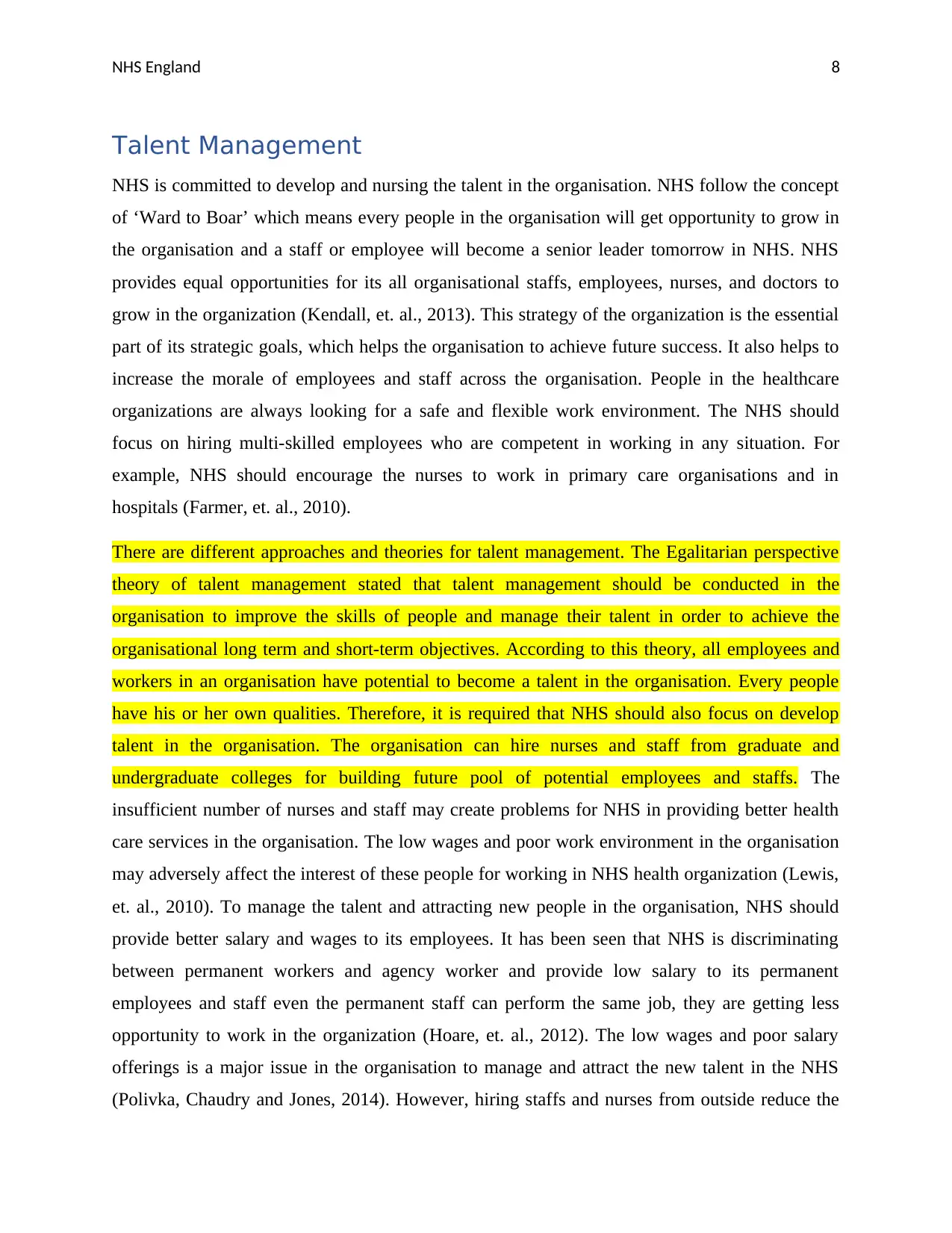
NHS England 8
Talent Management
NHS is committed to develop and nursing the talent in the organisation. NHS follow the concept
of ‘Ward to Boar’ which means every people in the organisation will get opportunity to grow in
the organisation and a staff or employee will become a senior leader tomorrow in NHS. NHS
provides equal opportunities for its all organisational staffs, employees, nurses, and doctors to
grow in the organization (Kendall, et. al., 2013). This strategy of the organization is the essential
part of its strategic goals, which helps the organisation to achieve future success. It also helps to
increase the morale of employees and staff across the organisation. People in the healthcare
organizations are always looking for a safe and flexible work environment. The NHS should
focus on hiring multi-skilled employees who are competent in working in any situation. For
example, NHS should encourage the nurses to work in primary care organisations and in
hospitals (Farmer, et. al., 2010).
There are different approaches and theories for talent management. The Egalitarian perspective
theory of talent management stated that talent management should be conducted in the
organisation to improve the skills of people and manage their talent in order to achieve the
organisational long term and short-term objectives. According to this theory, all employees and
workers in an organisation have potential to become a talent in the organisation. Every people
have his or her own qualities. Therefore, it is required that NHS should also focus on develop
talent in the organisation. The organisation can hire nurses and staff from graduate and
undergraduate colleges for building future pool of potential employees and staffs. The
insufficient number of nurses and staff may create problems for NHS in providing better health
care services in the organisation. The low wages and poor work environment in the organisation
may adversely affect the interest of these people for working in NHS health organization (Lewis,
et. al., 2010). To manage the talent and attracting new people in the organisation, NHS should
provide better salary and wages to its employees. It has been seen that NHS is discriminating
between permanent workers and agency worker and provide low salary to its permanent
employees and staff even the permanent staff can perform the same job, they are getting less
opportunity to work in the organization (Hoare, et. al., 2012). The low wages and poor salary
offerings is a major issue in the organisation to manage and attract the new talent in the NHS
(Polivka, Chaudry and Jones, 2014). However, hiring staffs and nurses from outside reduce the
Talent Management
NHS is committed to develop and nursing the talent in the organisation. NHS follow the concept
of ‘Ward to Boar’ which means every people in the organisation will get opportunity to grow in
the organisation and a staff or employee will become a senior leader tomorrow in NHS. NHS
provides equal opportunities for its all organisational staffs, employees, nurses, and doctors to
grow in the organization (Kendall, et. al., 2013). This strategy of the organization is the essential
part of its strategic goals, which helps the organisation to achieve future success. It also helps to
increase the morale of employees and staff across the organisation. People in the healthcare
organizations are always looking for a safe and flexible work environment. The NHS should
focus on hiring multi-skilled employees who are competent in working in any situation. For
example, NHS should encourage the nurses to work in primary care organisations and in
hospitals (Farmer, et. al., 2010).
There are different approaches and theories for talent management. The Egalitarian perspective
theory of talent management stated that talent management should be conducted in the
organisation to improve the skills of people and manage their talent in order to achieve the
organisational long term and short-term objectives. According to this theory, all employees and
workers in an organisation have potential to become a talent in the organisation. Every people
have his or her own qualities. Therefore, it is required that NHS should also focus on develop
talent in the organisation. The organisation can hire nurses and staff from graduate and
undergraduate colleges for building future pool of potential employees and staffs. The
insufficient number of nurses and staff may create problems for NHS in providing better health
care services in the organisation. The low wages and poor work environment in the organisation
may adversely affect the interest of these people for working in NHS health organization (Lewis,
et. al., 2010). To manage the talent and attracting new people in the organisation, NHS should
provide better salary and wages to its employees. It has been seen that NHS is discriminating
between permanent workers and agency worker and provide low salary to its permanent
employees and staff even the permanent staff can perform the same job, they are getting less
opportunity to work in the organization (Hoare, et. al., 2012). The low wages and poor salary
offerings is a major issue in the organisation to manage and attract the new talent in the NHS
(Polivka, Chaudry and Jones, 2014). However, hiring staffs and nurses from outside reduce the
⊘ This is a preview!⊘
Do you want full access?
Subscribe today to unlock all pages.

Trusted by 1+ million students worldwide
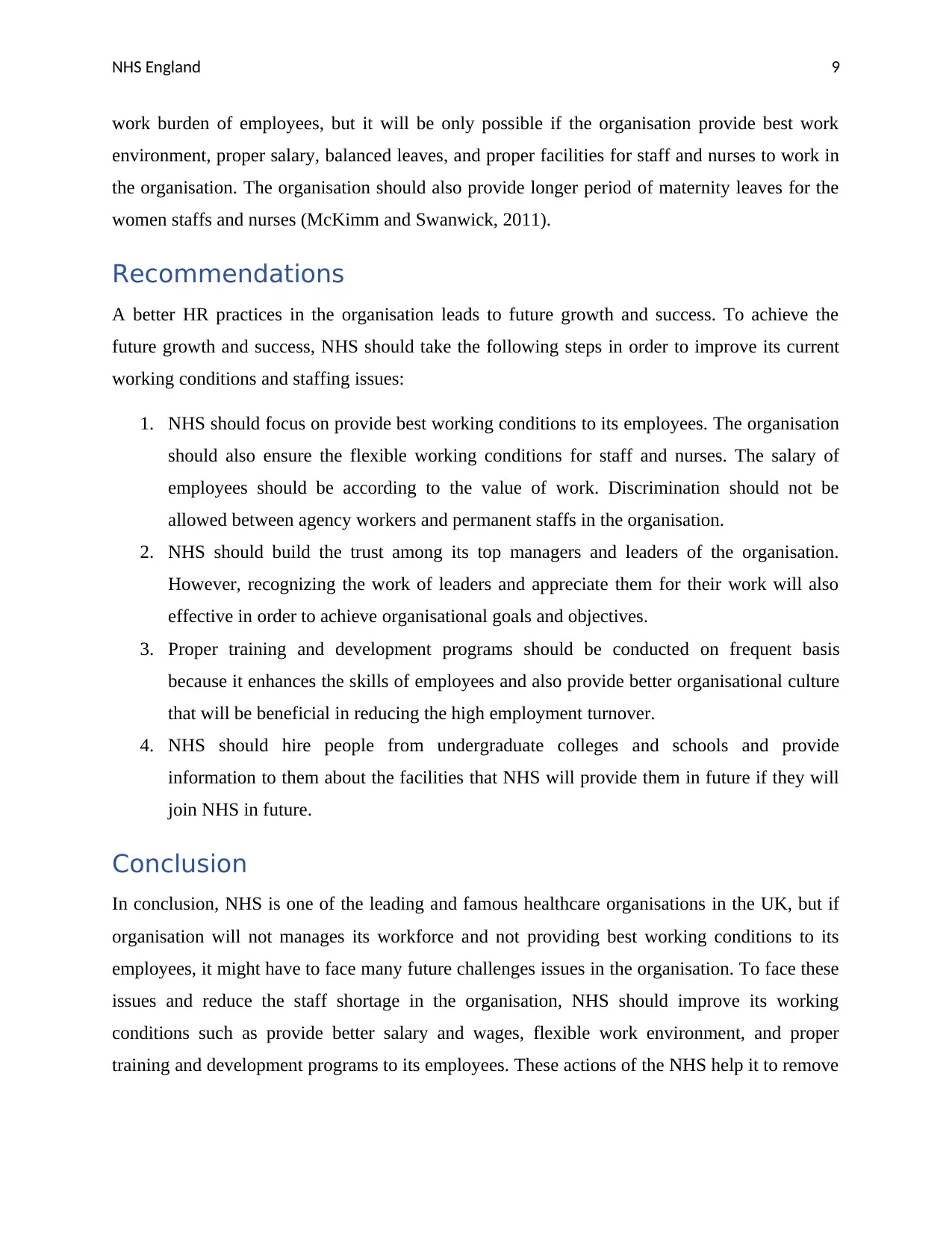
NHS England 9
work burden of employees, but it will be only possible if the organisation provide best work
environment, proper salary, balanced leaves, and proper facilities for staff and nurses to work in
the organisation. The organisation should also provide longer period of maternity leaves for the
women staffs and nurses (McKimm and Swanwick, 2011).
Recommendations
A better HR practices in the organisation leads to future growth and success. To achieve the
future growth and success, NHS should take the following steps in order to improve its current
working conditions and staffing issues:
1. NHS should focus on provide best working conditions to its employees. The organisation
should also ensure the flexible working conditions for staff and nurses. The salary of
employees should be according to the value of work. Discrimination should not be
allowed between agency workers and permanent staffs in the organisation.
2. NHS should build the trust among its top managers and leaders of the organisation.
However, recognizing the work of leaders and appreciate them for their work will also
effective in order to achieve organisational goals and objectives.
3. Proper training and development programs should be conducted on frequent basis
because it enhances the skills of employees and also provide better organisational culture
that will be beneficial in reducing the high employment turnover.
4. NHS should hire people from undergraduate colleges and schools and provide
information to them about the facilities that NHS will provide them in future if they will
join NHS in future.
Conclusion
In conclusion, NHS is one of the leading and famous healthcare organisations in the UK, but if
organisation will not manages its workforce and not providing best working conditions to its
employees, it might have to face many future challenges issues in the organisation. To face these
issues and reduce the staff shortage in the organisation, NHS should improve its working
conditions such as provide better salary and wages, flexible work environment, and proper
training and development programs to its employees. These actions of the NHS help it to remove
work burden of employees, but it will be only possible if the organisation provide best work
environment, proper salary, balanced leaves, and proper facilities for staff and nurses to work in
the organisation. The organisation should also provide longer period of maternity leaves for the
women staffs and nurses (McKimm and Swanwick, 2011).
Recommendations
A better HR practices in the organisation leads to future growth and success. To achieve the
future growth and success, NHS should take the following steps in order to improve its current
working conditions and staffing issues:
1. NHS should focus on provide best working conditions to its employees. The organisation
should also ensure the flexible working conditions for staff and nurses. The salary of
employees should be according to the value of work. Discrimination should not be
allowed between agency workers and permanent staffs in the organisation.
2. NHS should build the trust among its top managers and leaders of the organisation.
However, recognizing the work of leaders and appreciate them for their work will also
effective in order to achieve organisational goals and objectives.
3. Proper training and development programs should be conducted on frequent basis
because it enhances the skills of employees and also provide better organisational culture
that will be beneficial in reducing the high employment turnover.
4. NHS should hire people from undergraduate colleges and schools and provide
information to them about the facilities that NHS will provide them in future if they will
join NHS in future.
Conclusion
In conclusion, NHS is one of the leading and famous healthcare organisations in the UK, but if
organisation will not manages its workforce and not providing best working conditions to its
employees, it might have to face many future challenges issues in the organisation. To face these
issues and reduce the staff shortage in the organisation, NHS should improve its working
conditions such as provide better salary and wages, flexible work environment, and proper
training and development programs to its employees. These actions of the NHS help it to remove
Paraphrase This Document
Need a fresh take? Get an instant paraphrase of this document with our AI Paraphraser

NHS England 10
the issues related to low level staffing problems and further help to attract the potential
employees and nurses towards the organisation.
the issues related to low level staffing problems and further help to attract the potential
employees and nurses towards the organisation.
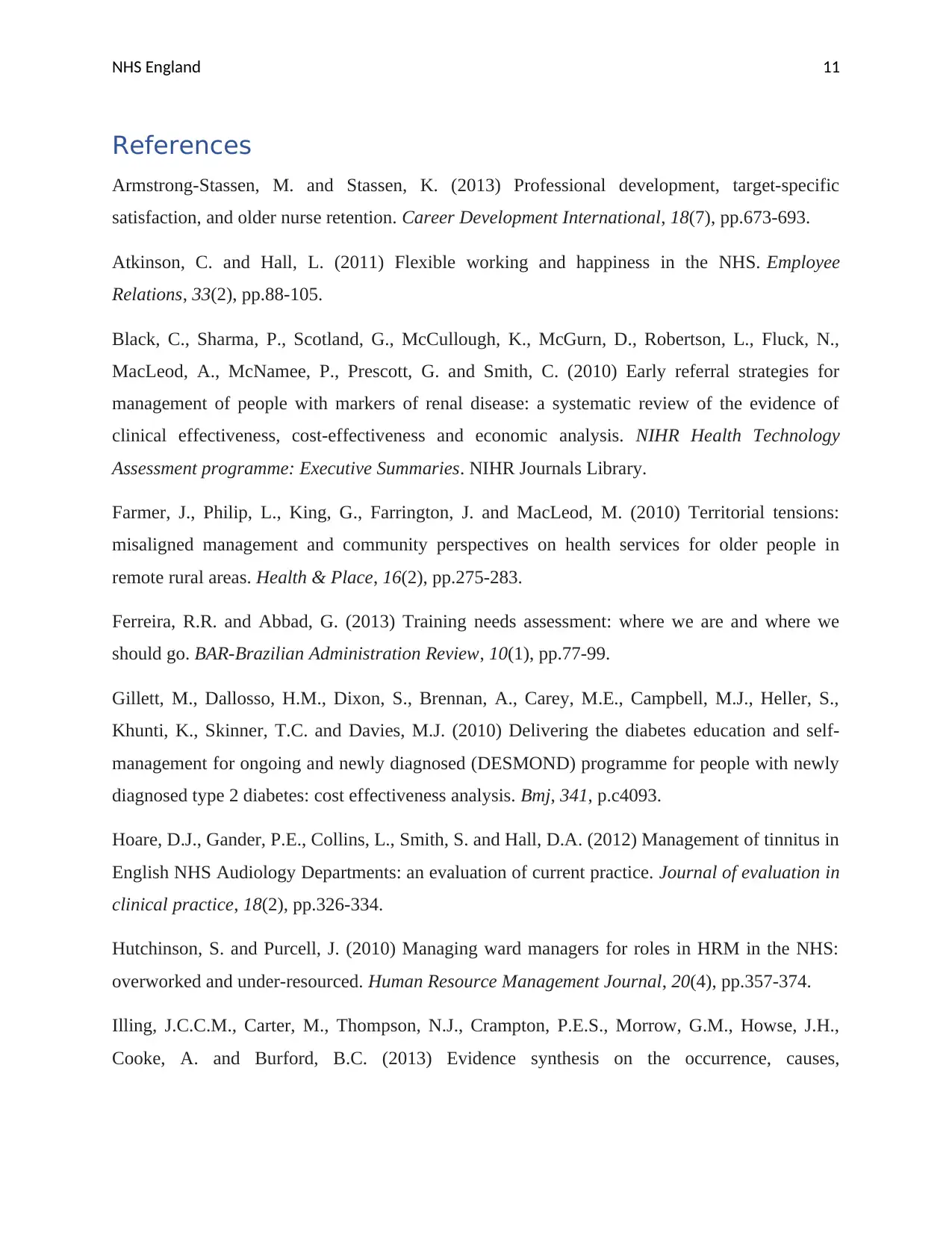
NHS England 11
References
Armstrong-Stassen, M. and Stassen, K. (2013) Professional development, target-specific
satisfaction, and older nurse retention. Career Development International, 18(7), pp.673-693.
Atkinson, C. and Hall, L. (2011) Flexible working and happiness in the NHS. Employee
Relations, 33(2), pp.88-105.
Black, C., Sharma, P., Scotland, G., McCullough, K., McGurn, D., Robertson, L., Fluck, N.,
MacLeod, A., McNamee, P., Prescott, G. and Smith, C. (2010) Early referral strategies for
management of people with markers of renal disease: a systematic review of the evidence of
clinical effectiveness, cost-effectiveness and economic analysis. NIHR Health Technology
Assessment programme: Executive Summaries. NIHR Journals Library.
Farmer, J., Philip, L., King, G., Farrington, J. and MacLeod, M. (2010) Territorial tensions:
misaligned management and community perspectives on health services for older people in
remote rural areas. Health & Place, 16(2), pp.275-283.
Ferreira, R.R. and Abbad, G. (2013) Training needs assessment: where we are and where we
should go. BAR-Brazilian Administration Review, 10(1), pp.77-99.
Gillett, M., Dallosso, H.M., Dixon, S., Brennan, A., Carey, M.E., Campbell, M.J., Heller, S.,
Khunti, K., Skinner, T.C. and Davies, M.J. (2010) Delivering the diabetes education and self-
management for ongoing and newly diagnosed (DESMOND) programme for people with newly
diagnosed type 2 diabetes: cost effectiveness analysis. Bmj, 341, p.c4093.
Hoare, D.J., Gander, P.E., Collins, L., Smith, S. and Hall, D.A. (2012) Management of tinnitus in
English NHS Audiology Departments: an evaluation of current practice. Journal of evaluation in
clinical practice, 18(2), pp.326-334.
Hutchinson, S. and Purcell, J. (2010) Managing ward managers for roles in HRM in the NHS:
overworked and under‐resourced. Human Resource Management Journal, 20(4), pp.357-374.
Illing, J.C.C.M., Carter, M., Thompson, N.J., Crampton, P.E.S., Morrow, G.M., Howse, J.H.,
Cooke, A. and Burford, B.C. (2013) Evidence synthesis on the occurrence, causes,
References
Armstrong-Stassen, M. and Stassen, K. (2013) Professional development, target-specific
satisfaction, and older nurse retention. Career Development International, 18(7), pp.673-693.
Atkinson, C. and Hall, L. (2011) Flexible working and happiness in the NHS. Employee
Relations, 33(2), pp.88-105.
Black, C., Sharma, P., Scotland, G., McCullough, K., McGurn, D., Robertson, L., Fluck, N.,
MacLeod, A., McNamee, P., Prescott, G. and Smith, C. (2010) Early referral strategies for
management of people with markers of renal disease: a systematic review of the evidence of
clinical effectiveness, cost-effectiveness and economic analysis. NIHR Health Technology
Assessment programme: Executive Summaries. NIHR Journals Library.
Farmer, J., Philip, L., King, G., Farrington, J. and MacLeod, M. (2010) Territorial tensions:
misaligned management and community perspectives on health services for older people in
remote rural areas. Health & Place, 16(2), pp.275-283.
Ferreira, R.R. and Abbad, G. (2013) Training needs assessment: where we are and where we
should go. BAR-Brazilian Administration Review, 10(1), pp.77-99.
Gillett, M., Dallosso, H.M., Dixon, S., Brennan, A., Carey, M.E., Campbell, M.J., Heller, S.,
Khunti, K., Skinner, T.C. and Davies, M.J. (2010) Delivering the diabetes education and self-
management for ongoing and newly diagnosed (DESMOND) programme for people with newly
diagnosed type 2 diabetes: cost effectiveness analysis. Bmj, 341, p.c4093.
Hoare, D.J., Gander, P.E., Collins, L., Smith, S. and Hall, D.A. (2012) Management of tinnitus in
English NHS Audiology Departments: an evaluation of current practice. Journal of evaluation in
clinical practice, 18(2), pp.326-334.
Hutchinson, S. and Purcell, J. (2010) Managing ward managers for roles in HRM in the NHS:
overworked and under‐resourced. Human Resource Management Journal, 20(4), pp.357-374.
Illing, J.C.C.M., Carter, M., Thompson, N.J., Crampton, P.E.S., Morrow, G.M., Howse, J.H.,
Cooke, A. and Burford, B.C. (2013) Evidence synthesis on the occurrence, causes,
⊘ This is a preview!⊘
Do you want full access?
Subscribe today to unlock all pages.

Trusted by 1+ million students worldwide
1 out of 14
Related Documents
Your All-in-One AI-Powered Toolkit for Academic Success.
+13062052269
info@desklib.com
Available 24*7 on WhatsApp / Email
![[object Object]](/_next/static/media/star-bottom.7253800d.svg)
Unlock your academic potential
Copyright © 2020–2025 A2Z Services. All Rights Reserved. Developed and managed by ZUCOL.





